Growth isn’t just about having a great product or service; it’s about how effectively your teams work together to bring that offering to market. Sales and marketing are often seen as separate engines driving revenue, but when they’re aligned, they become a powerful force for scalable, sustainable growth.
By aligning sales and marketing to work toward the same goals, organizations have an easier time building a more loyal and dedicated consumer base.
Join us below in exploring how businesses can prioritize growth by bridging the gap between these two critical functions.
Learn how marketing can become a powerful growth engine in your organization by watching Impact’s webinar, Scientific Marketing: Transforming Bold Ideas Into Bottom-Line Results.
When Sales and Marketing Are Disconnected
Sales and marketing misalignment is more common than most organizations would like to admit. Despite sharing the same ultimate goal—revenue growth—these teams often operate with different metrics, strategies, and even definitions of success.
Here’s what misalignment typically looks like:
- Conflicting messaging: Marketing promotes one value proposition, while sales emphasizes another
- Poor lead quality or handoff: Marketing generates leads that sales doesn’t consider qualified, leading to wasted effort
- Lack of shared data: Insights from customer interactions aren’t looped back into marketing strategies
- Finger-pointing: When targets aren’t met, each team blames the other
This disconnect creates internal friction and directly impacts the customer experience. Prospects receive inconsistent messaging, delayed responses, or irrelevant offers, which erodes trust and reduces conversion rates.
While these issues may seem daunting, the first step in addressing them is recognizing the symptoms and committing to a more integrated and unified approach.
Identify Overlapping Goals
Sales and marketing may approach growth from different angles, but their success hinges on shared outcomes. Identifying overlapping goals is the foundation for building trust, improving collaboration, and driving unified performance.
At the core, both teams want:
- More qualified leads
- Higher conversion rates
- Increased customer retention
- Revenue growth
The challenge is that these goals are often framed differently. Marketing might focus on brand awareness and lead generation, while sales zeroes in on closing deals and hitting quotas. Without a shared understanding, efforts can feel disconnected, even when they’re aimed at the same target.
To bridge this gap, start by facilitating joint planning sessions. These should focus on:
- Defining what a “qualified lead” means to both teams
- Agreeing on target customer profiles and pain points
- Establishing shared KPIs like pipeline velocity, lead-to-opportunity conversion, and customer lifetime value
- Clarifying roles and responsibilities in the buyer journey
When goals are aligned and clearly communicated, both teams can operate with greater efficiency and purpose. Marketing knows what kind of content and campaigns will support sales, and sales can provide feedback that sharpens marketing’s strategy.
This alignment both improves internal collaboration and creates a more consistent and compelling experience for the customer.
Building a Unified Growth Strategy
A unified growth strategy begins with a mindset shift: sales and marketing are not separate entities; they’re co-architects of the customer journey. To build a strategy that truly drives business growth, both teams must be involved from the ground up, contributing insights, shaping messaging, and aligning on execution.
This starts with a shared understanding of the target audience. Marketing brings data on buyer behavior, content engagement, and campaign performance, while sales contributes firsthand knowledge of objections, motivations, and deal dynamics. When these perspectives are combined, the result is a more accurate and actionable customer profile.
Next comes the strategic planning itself. Instead of marketing launching campaigns in isolation and sales reacting to the leads that come in, both teams should co-develop initiatives that support each stage of the funnel. That means agreeing on the messaging, timing, and channels that will be used to attract, nurture, and convert prospects.
Technology plays a key role here, but it’s not the solution on its own. CRM systems, marketing automation platforms, and shared dashboards can help track progress and surface insights, but they only work when the strategy behind them is cohesive. The real power lies in the collaboration: regular check-ins, joint reviews of performance data, and a culture that values feedback over finger-pointing.
Ultimately, a unified growth strategy promotes alignment and co-ownership. When sales and marketing are equally invested in the plan, they’re more agile, more accountable, and more effective at driving results.
Aligning Messaging and Action
Strategic alignment between sales and marketing only works when messaging and execution are consistent. Marketing shapes the narrative through campaigns and content, but if sales conversations don’t reflect that same positioning, the customer experience becomes disjointed.
Prospects notice when what they read and what they hear don’t match, and that disconnect can erode trust.
To prevent this, both teams should collaborate on a shared messaging framework. This doesn’t mean scripting every interaction, but it does mean agreeing on how the company’s value is communicated across all touchpoints.
From ad copy to sales presentations, the language, tone, and key messages should reinforce one another and reflect a unified brand voice.
Execution is just as critical. If marketing promotes a specific solution or promise, sales must be equipped to deliver on it. Likewise, when sales encounters recurring objections or questions, that insight should inform future marketing content. This feedback loop ensures that messaging stays relevant and grounded in real customer conversations.
When messaging and action are aligned, the result is a smoother, more credible buyer journey. Prospects feel like they’re being guided, not sold to, because every interaction builds on the last with clarity and consistency.
The Benefits of Aligned Sales and Marketing
When sales and marketing operate in sync, the impact on business growth is both immediate and long-lasting. Alignment can streamline internal processes, reshape how your organization engages with customers, help you adapt to market changes, and drive revenue.
One of the most noticeable benefits is improved lead quality. When marketing understands what sales considers a qualified lead, campaigns become more focused and effective. Sales teams spend less time chasing cold prospects and more time closing deals with buyers who are ready to move forward.
Aligned teams also deliver a more consistent and compelling customer experience. From the first touchpoint to post-sale follow-up, messaging feels cohesive and intentional. This builds trust, strengthens relationships, and increases the likelihood of repeat business.
Here are some of the most impactful benefits businesses see when sales and marketing are aligned:
- Shorter sales cycles through better lead targeting and nurturing
- Higher conversion rates due to consistent messaging and timely follow-up
- Improved customer retention thanks to a seamless experience across departments
- Greater agility in responding to market shifts and customer feedback
- Stronger team morale driven by shared goals and mutual accountability
Ultimately, alignment creates a growth engine that’s more resilient and scalable.
Wrapping Up on Scaling Your Business by Aligning Initiatives
Scaling a business is about more than increasing output. When sales and marketing are aligned, growth becomes more strategic and sustainable. Instead of working in parallel, these teams operate as a unified force, driving consistent messaging, smarter targeting, and a more seamless customer experience.
As your organization grows, so does the complexity of your go-to-market efforts. New products, audiences, and channels demand tighter coordination. Regularly revisiting shared goals, refining messaging based on real-time feedback, and investing in collaborative tools ensures that alignment scales with the business, not against it.
Ultimately, the companies that scale successfully are those where sales and marketing initiatives are built on trust, transparency, and shared ownership of outcomes. Alignment isn’t a supporting tactic; it’s a core growth strategy that turns collaboration into a competitive advantage.
For more information on creating a marketing strategy that drives business growth, watch Impact’s webinar, Scientific Marketing: Transforming Bold Ideas Into Bottom-Line Results.



